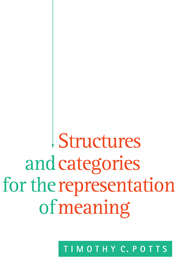4 - Categorial graphs
Published online by Cambridge University Press: 23 September 2009
Summary
SCOPEWAYS
My principal criticism of the graphs proposed by computer scientists for the representation of meaning has been that they do not provide for scope relationships and that, in consequence, they are unable to comprehend a straightforward account of quantification. At the end of section 2.5 I also argued that Frege's account of quantification involves graph structures, although this is concealed by his mixture of a planar and a linear notation. We need, therefore, to take up the computer scientists' idea of using graphs to represent meaning, but to give it a sound foundation by using the notion of scope as their principle of organization. This will lead to two extensions of the notion of scope.
In my original account of Fregean grammar (Potts, 1973), I added numerical super-scripts to the letters occurring in category names as scope indicators. The reason for this was to show, for operators of degree > 1, which operand corresponded to which of their operand-places. This meant that the linear order of C1…Cn in a category name was of no consequence to the structure represented. (We have already seen in section 2.5 that certain derivations require that we be able to change the linear ordering of these items.) Thus, to take the simplest example, instead of representing a structure for
(1) Dr Patel visited Mrs Wilson
simply by ‘S(N,N) N N’, it is represented by ‘S(N1, N2) N2 N1’.
- Type
- Chapter
- Information
- Structures and Categories for the Representation of Meaning , pp. 131 - 175Publisher: Cambridge University PressPrint publication year: 1994



